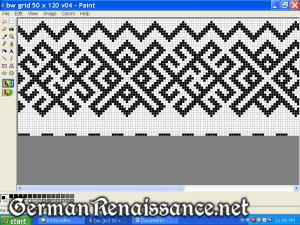One of the few extant pieces of early 16th century female garb (1521) remaining today is Mary of Hapsburg’s wedding dress. Mary was the granddaughter of Holy Roman Emperor Maximillian. The gown and chemise are housed in the Hungarian National Museum. The hemd (chemise) may or may not go with the gown (according to museum docents), but it is believed that the hemd is from the 16th century. I suspect that this hemd does go with the gown, or at least one very like it, for there exists a stove tile from 1490 which depicts a similar gown with a similar hemd. I don’t think a brustfleck would necessarily be worn with this gown either, as we have more pictorial evidence that it was not worn.
If you’re interested in making this hemd, first you need the cutting diagram. Credit for the cutting diagram goes to József Höllrigl (did an analysis in 1929), Mária V. Ember (wrote an article in 1962), Julia Palotay Szent-Györgyi (translated article and cutting diagram), and Cynthia Virtue. For more information on the attributions, see http://www.virtue.to/guest_authors/hungarian.html

Detail of the cutting diagram showing the hemd pattern (click to view original image)
Important note on above diagram: The three panels are NOT cut out as trapezoids; they are cut out as rectangles. They only become trapezoidal after the pleating.
From Maria Ember’s 1962 article, “The blouse’s front and back are each made of three trapezoidal pieces. The pieces are 40 cm wide at the top, 60 cm at the bottom. They’re attached to each other with 1 cm wide lines of silver embroidery in a blanket stitch. The two sides are widened further by two triangular gores, each 60 cm wide. The three front panels are gathered to a width of 21 cm, forming the front of the neckline. The gathered section is about 6 cm wide [Ed: I think they mean “deep” ie, width of smocking embroidery], secured by geometric satin-stitch embroidery in silver thread. The back sections are also gathered to 21 cm, with embroidery 1 cm narrower than on the front. The long, full sleeves are also assembled from three pieces attached to each other with silver blanket stitch. The sleeves are straight rectangles, 65 cm long, 122 cm wide, with the top sections gathered to 28 cm, and forming the sides of the neckline. The embroidery securing the gathers is only 3 cm wide. The neckline is enclosed in a 3 cm wide band. The wide sleeves are gathered to 24 cm at the wrist, sewn to a 1.5 cm wide cuff. The gathers are decorated with narrow silver embroidery in an interlocking half-circle pattern. The underarm gussets are 25 cm squares. The shirt’s material is a closely woven fine evenweave linen.”
I should note that there is some debate on the chemise and its pattern on the SCA-Garb Yahoo group, as seen here: http://groups.yahoo.com/neo/groups/Authentic_SCA/conversations/topics/24670
Once you have the hemd, you need the pattern for the pleatwork at the top. Glynnis Hollindale patterned the pattern darning on the pleatwork, and she’s given me permission to share it with you here. (Many thanks, Glynnis!)

Original pattern with fylfots
Glynnis has three patterns for the pleats, along with notes on materials, pleat size, and stitch size:
- The original pattern at the top of the hemd (with fylfots): GHMaryofHapsburgfrontpatternV1.0
- An alternate pattern for the top of the hemd (no flyfots): GHMaryofHapsburgalternatefrontpatternoptionsV1.1
- An option for the sleeve cuff (which she could not see): GHMaryofHapsburgsleeveoption2009
To learn more about pattern darning over pleatwork, check out the fall 2006 newsletter of the Needleworkers Guild in the Kingdom of the West, which has a whole issue on pattern darning!
My first attempt at Mary’s pattern is this apron, which is still in progress:

In-progress pattern darning over pleatwork
The biggest issue with my first attempt above is that the pleats are too deep and, thus, the apron is quite narrow. I think I have 1/4″ or 1/2″ pleats here, but they really should be more like 1/8″. The pleat depth didn’t effect the pattern darning, but it’s just a lot of material. This is fine if you have a lot of material that you want to pleat into a small space, but that was not the case here.
I also found it challenging to keep the pleats from tightening together as I stitched, and that had a lot to do with how tightly I pulled my stitch; once I realized it wanted to tighten, I went easier on my pulling. It worked out, as you can see the pattern above clearly and I don’t seen a variation between the top and the bottom width of the design.
The above pleatwork was just an exercise; I have no current plans to recreate this particular hemd.
If anyone out there makes a hemd after this pattern, I’d love to see it!
Images:
- http://www.flickr.com/photos/taryneast/sets/72157632440528862/with/6250080315/
- http://www.gogmsite.net/_Media/mary_of_habsburg_queen_of_h.png
- http://www.flickr.com/photos/92578357@N00/sets/72157594339287838/detail/
Links:

